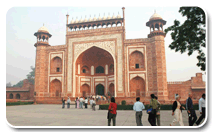FATEHPUR SIKRI
The UNESCO designated World Heritage Site of Fatehpur Sikri, is located 40 kilometers from Agra on the route towards Jaipur. This erstwhile magnificent city with amazing monuments of red sandstone and marble was built by the Mughal Emperor Akbar.
According to legend, though Emperor Akbar, had many wives, but did not have an heir. He went on a pilgrimage to Sheikh Salim Chisti, a Sufi saint who lived near Agra and sought his blessings. Thereafter, Akbar was blessed with an heir, who he named Salim, after the saint and built the city of Fatehpur Sikri as a sign of gratitude to Sheikh Salim Chisti.
Work on the city started in 1571 and was completed 15 years later. The beautiful monuments at Fatehpur Sikri are a synthesis of Islamic and Hindu architecture reflecting the religious tolerance of Akbar. Akbar also founded a syncretic religion called Din-i-Illahi, which inspired some of the buildings at Fatehpur Sikri.
Some of the grand structures at Fatehpur Sikri include:
- Panch Mahal - the 5-storeyed palace
- Tomb of Saint Salim Chisti
- Jama Masjid
- Life-size Chessboard where courtiers could play the role of pieces.


